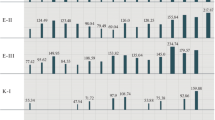Abstract
In experiments on introduction of mutation l(2)M167 DTS in Drosophila melanogaster populations, larval and pupal viability and developmental rate are limiting factors determining the intensity of selection on the l(2)M167 DTS mutation. Notwithstanding the rapid elimination of the mutation from the population, positive selection for viability was shown, which increased fitness of the mutation carriers in generations. The fitness component viability was estimated in individuals l(2)M167 DTS/+; relative to that of wild-type individuals, it varied from 0.5 to 1.0. Factors affecting this trait in overcrowded populations were found.
Similar content being viewed by others
REFERENCES
Fisher, R.A., The Genetical Theory of Natural Selection, Oxford: Clarendon, 1930.
Kingman, J.F.C., Mathematical Problems in Population Genetics, Proc. Camb. Phil. Soc., 1961, vol. 57, no.3, pp. 574–582.
Li, C.C., Fundamental Theorem of Natural Selection, Nature, 1967, vol. 214, no.5087, pp. 505–506.
Jungen, H. and Hartl, D.L., Average Fitness of Population of Drosophila melanogaster, As Estimated Using Compound Autosome Strains, Evolution, 1979, vol. 33, pp. 359–370.
Haymer, D.R. and Hartl, D.L., The Experimental Assessment of Fitness in Drosophila: I. Comparative Measures of Comparative Reproductive Success, Genetics, 1982, vol. 102, pp. 455–466.
Glotov, N.V., Tishkin, V.V., Kuznetsova, V.V., and Rakhman, M.I., General Fitness and Its Components in Drosophila melanogaster, in Ontogenez, evolyutsiya, biosfera (Ontogeny, Evolution, Biosphere), Moscow: Nauka, 1989, pp. 130–144.
Lazebnyi, O.E., Imasheva, A.G., and Zhivotovsky, L.A., Fitness of Experimental Drosophila melanogaster Populations in Directional or Stabilizing Selection, Genetika (Moscow), 1991, vol. 27, no.10, pp. 1726–1732.
Mukai, T. and Burdick, A.B., Single Gene Heterosis Associated with Second Chromosome Recessive Lethal in Drosophila melanogaster, Genetics, 1959, vol. 44, pp. 211–232.
Benedik, J., Evaluation of Components of Fitness for Recessive Lethal Heterozygotes: II. Utilization of the Model, Scr. Fac. Sci. Univ. Purk. Brun, 1981, vol. 11, nos.3–4, pp. 150–181.
Spiess, E.B. and Spiess, L.D., Selection for Rate of Development and Gene Arrangement Frequencies in Drosophila persimilis: II. Fitness Properties at Equilibrium, Genetics, 1966, vol. 53, no.4, pp. 695–708.
Barclay, H.J. and Fitz-Farle, M., Maximum Likelihood Estimates of Fitness in Iteroparous Species Population Replacement Experiments Using Compound Chromosomes, Genome, 1988, vol. 30, no.1, pp. 83–88.
Mettler, L.E. and Gregg, T.G., Population Genetics and Evolution, Englewood Cliffs, New Jersey: Prentige-Hall, 1969.
Gailey, D.A., Hall, J.S., and Siegel, R.W., Reduced Reproductive Success for a Conditioning Mutant in Experimental Populations of Drosophila melanogaster, Genetics, 1985, vol. 111, no.4, pp. 795–807.
Sondergaard, L., Mating Competition in Artificial Populations of Drosophila melanogaster Polymorphic for ebony: II. A Test for Minority Male Mating Advantage, Genet. Res., 1986, vol. 47, no.3, pp. 205–208.
Kyriacou, C.P., Long-Term ebony Polymorphism: A Comparison of the Contributions of Behavioral and Nonbehavioral Fitness Characters, Behav. Genet., 1985, vol. 15, no.2, pp. 165–180.
Rasmuson, M., Variation in Persistence of Gene Frequency Changes in Laboratory Populations of Drosophila melanogaster, Hereditas (Lund, Swed.), 1970, vol. 65, no.1, pp. 57–63.
Barnes, P.T., Holland, B., and Courreges, V., Genotype-by-Environment and Epistatic Interactions in Drosophila melanogaster: The Effects of Gpdh Allozymes, Genetic Background and Rearing Temperature on Larval Developmental Time and Viability, Genetics, 1989, vol. 122, pp. 859–868.
Hemmat, M. and Eggleston, P., The Biometrical Genetics of Competitive Parameters in Drosophila melanosgaster, Heredity, 1990, vol. 64, no.2, pp. 215–231.
Kulikov, A.M., Marets, F., and Mitrofanov, V.G., Effect of Population Density on the Dynamics of the Exclusion of the l(2)M167 DTS Recessive Lethal Mutation from Experimental Populations, Rus. J. Genet., 2005, vol. 41, no.3, pp. 249–255.
Kulikov, A.M., Marets, F., and Mitrofanov, V.G., Effects of Male Competitiveness, Developmental Rate, and Larval and Pupal Viability of Drosophila melanogaster Heterozygotes for the Temperature-Sensitive Lethal Mutation l(2)M167 DTS on the Dynamics of the Exclusion of the Mutation from a Population, Rus. J. Genet., 2005, vol. 41, no.5, pp. 620–625.
Kulikov, A.M. and Myasnyankina, E.N., Effect of the l(2)M167 DTS Temperature-Sensitive Mutation on the Viability of Heterozygous Embryos, Larvae, and Pupae of Drosophila melanogaster, Rus. J. Genet., 1994, vol. 30, no.7, pp. 798–804.
Kulikov, A.M., Mitrofanov, V.G., Myasnyankina, E.N., and Generalova, M.V., Efficiency of Introduction of a Sominant Temperature-Sensitive Mutation in a Drosophila melanogaster Population under Near-Natural Conditions, Zh. Obshch. Biol., 1988, vol. 49, no.6, pp. 765–776.
Timofeeff-Ressovsky, N.W., Uber die Vitalitat einiger Genmutationen und ihrer Kombinationen bei Drosophila funebris und ihre Abhangigkeit vom genotypischen und vom ausseren Milieu, Z. Induct. Abstammungs-Vererbungslehre, 1934, vol. 66, p. 319.
Benedik, J. and Franek, J., Evaluation of Components of Fitness for Recessive Lethal Heterozygotes: I. Arrangement of the Model, Scr. Fac. Sci. Univ. Purk. Brun., 1981, vol. 11, nos.3–4, pp. 135–150.
Molina, F., Conzalez-Candelas, F., and Mensua, J.L., Density-and Frequency-Dependent Selection in Drosophila melanogaster, Dros. Inf. Serv., 1987, vol. 66, pp. 102–103.
Molina, F., Conzalez-Candelas, F., and Mensua, J.L., Effect of the Spatial Disposition of Food in Larval Competition of Drosophila melanogaster, Dros. Inf. Serv., 1987, vol. 66, p. 104.
De Miranda, F.R. and Eggleston, P., Analysis of Dominance for Competitive Ability in Drosophila melanogaster, Heredity, 1989, vol. 63, no.2, pp. 221–229.
Moya, A., Gonzalez-Candelas, F., and Mensua, J.L., Larval Competition in Drosophila melanogaster: Frequency Dependence of Viability, Theor. Appl. Genet., 1988, vol. 75, no.2, pp. 366–377.
Author information
Authors and Affiliations
Additional information
__________
Translated from Genetika, Vol. 41, No. 6, 2005, pp. 759–766.
Original Russian Text Copyright © 2005 by Kulikov, Marec, Mitrofanov.
Rights and permissions
About this article
Cite this article
Kulikov, A.M., Marec, F. & Mitrofanov, V.G. Selection on Viability of Individuals Heterozygous for the Temperature-Sensitive Lethal Mutation l(2)M167 DTS in Experimental Populations of Drosophila melanogaster . Russ J Genet 41, 613–619 (2005). https://doi.org/10.1007/s11177-005-0135-4
Received:
Issue Date:
DOI: https://doi.org/10.1007/s11177-005-0135-4




